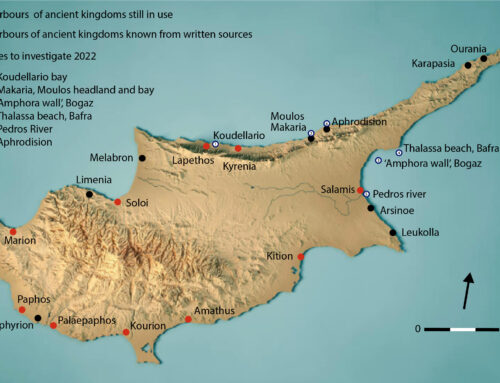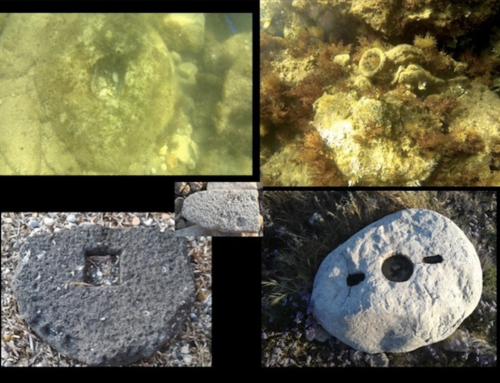The Athlit ram revisited: technical metallurgical and provenance analysis coupled with surface mapping and 3D modeling of the ram and its timbers
Asaf Oron
Summary

Preliminary point cloud of the Athlit Ram
A dramatic increase in the corpus of naval ram finds and their research in the past few years (Tusa and Royal 2012; Adams et al. 2013; Buccellato and Tusa 2013; Prag 2014) and advances in analytical and recording tools bring with them a renewed interest in further analysis of the Athlit ram and provide powerful means for its investigation and recording. In light of this reality and building upon the previous studies of the ram, the current research conducted further study of the Athlit ram and its timbers at the National Maritime Museum in Haifa. The study applied new imaging technology alongside metallurgical and chemical analyses in order to collect new data that was used to clarify issues related to the construction of the ram, its relations to the bow on which it was mounted, its repairs, and its possible origin.
The study was motivated by the dramatic increase in the corpus of extent naval rams in recent years and the advance in analytical and imaging techniques since the completion of previous studies on the ram. These studies showed that the ram was manufactured by the lost wax technique (Oron 2006) and not by the sand casting method as previously proposed (Eisenberg 1991). The former method was adjusted in order to facilitate a close fit between the cast ram and the bow timbers it was to be placed over. It was also noticed that the ram casting had been extensively repaired. Examination and analysis of some of these repairs (Oron 2006: 67, table 2) showed that they carried the hallmark of Classical and Hellenistic bronze craftsmanship closely linked with the use of the lost wax casting technique for the manufacture of small and large bronzes. Using new tools in the area of high resolution imaging techniques alongside further elemental analyses and lead isotope studies the current research provides further information on the geographical origin of the ram, the nature and chronology of its repairs and the spatial interrelations between the bronze cast and the bow timbers.
Methodology

Dr.L.Repola scanning the ramming timbers
Application of high resolution imaging techniques:
Our first field campaign to the National Maritime Museum focused on a high resolution three-dimensional and surface recording of the ram and its timbers using a structured light scanner and images based systems.
The acquired data was then used to produce a high-resolution textured model and to create several study models of the ram and its bow timbers.
Collection of alloy samples for Metallurgical and Lead Isotope analysis:
Our second field campaign was aimed at collecting a set of metal samples from the repairs on the ram and from the ram main casting. These samples were subjected to two sets of Analyses:
• Microwave-plasma atomic emission spectrometry (MP-AES); a new technology for major, minor and trace element characterization of the alloys used in the construction and repair of the ram.
• Lead Isotope analysis, a technique that has not been applied to the ram so far and allowed for the first time to provide chemical sourcing information on the origins of the copper alloys used in the casting of the ram and its repairs.
Results

Dr M. Ponting collecting metal samples by drilling the ramming head
High resolution imaging techniques
The application of high resolution imaging techniques allowed to create a surface map of the ram, 3D models of the bronze cast and the bow timbers. The application of these new technologies supports the previous investigators (Steffy 1983, 1991, Oron 2001) in terms of their accuracy and overall observations. At the same time they take the technical investigation of the ram further ahead. The computer models allow various virtual manipulation and assembly tests of the ramming timbers and the ram which are not possible with the real object. They also comprise a durable and easily shared vector-graphic-based record of the ram and its timbers. Altogether these tools allow a renewed look at the morphology of the ram and its timbers in a way not possible before.
Chemical investigation
The study confirms that the ram is made of an un-leaded bronze containing an average of 8.5% tin. It appears that the copper for the main cast came from Cyprus. The provenance of other alloy types, found on the ram repairs and that of one fastener are still undergoing interpretation.
Variations in the composition of the different repairs suggest four possible repair campaigns on of the ram. Two of these campaigns were carried out soon after the ram casting while the others were conducted later at two separate events which may be linked to the ram useful life and its use in battle.
The study enabled us to meet our research goals as follows:
1. It provides new information on the morphological correlation between the bronze cast and the bow timbers.
2. It provides new technical information that clarifies the nature of the repairs on the ram, the relative chronology of their application and the provenance of their copper.
3. It suggests that the origin of the copper used in the main casting of the ram is from Cyprus thus possibly supporting its previously speculated production place on Cyprus.
4. It creates a vector-graphic-based set of models of the ram and its bow timbers to be used as a durable record of this important cultural heritage remain and as a powerful research tool by other scholars.
Conclusions
The study significantly broadens our understanding of the production techniques and repair of naval rams – the prime weapon of the Classical and Hellenistic maritime world. It confirms in a vivid visual way the intimate linkage between the bronze cast and the bow timbers on which the ram was mounted. Thus further supporting a close connection between shipwrights and foundry man in the military shipyards.
The repairs on the ram attest to the continuous effort to keep the ram look and physical integrity after its manufacture and throughout its useful life.
The use of high resolution imaging techniques in this study proves to be a powerful tool for the technical analysis of complex cultural heritage remains such as the Athlit ram and its bow timbers.
Future study of the ram will focus on its functional use in battle as an impact weapon and the implications to the warships on which it was mounted.



